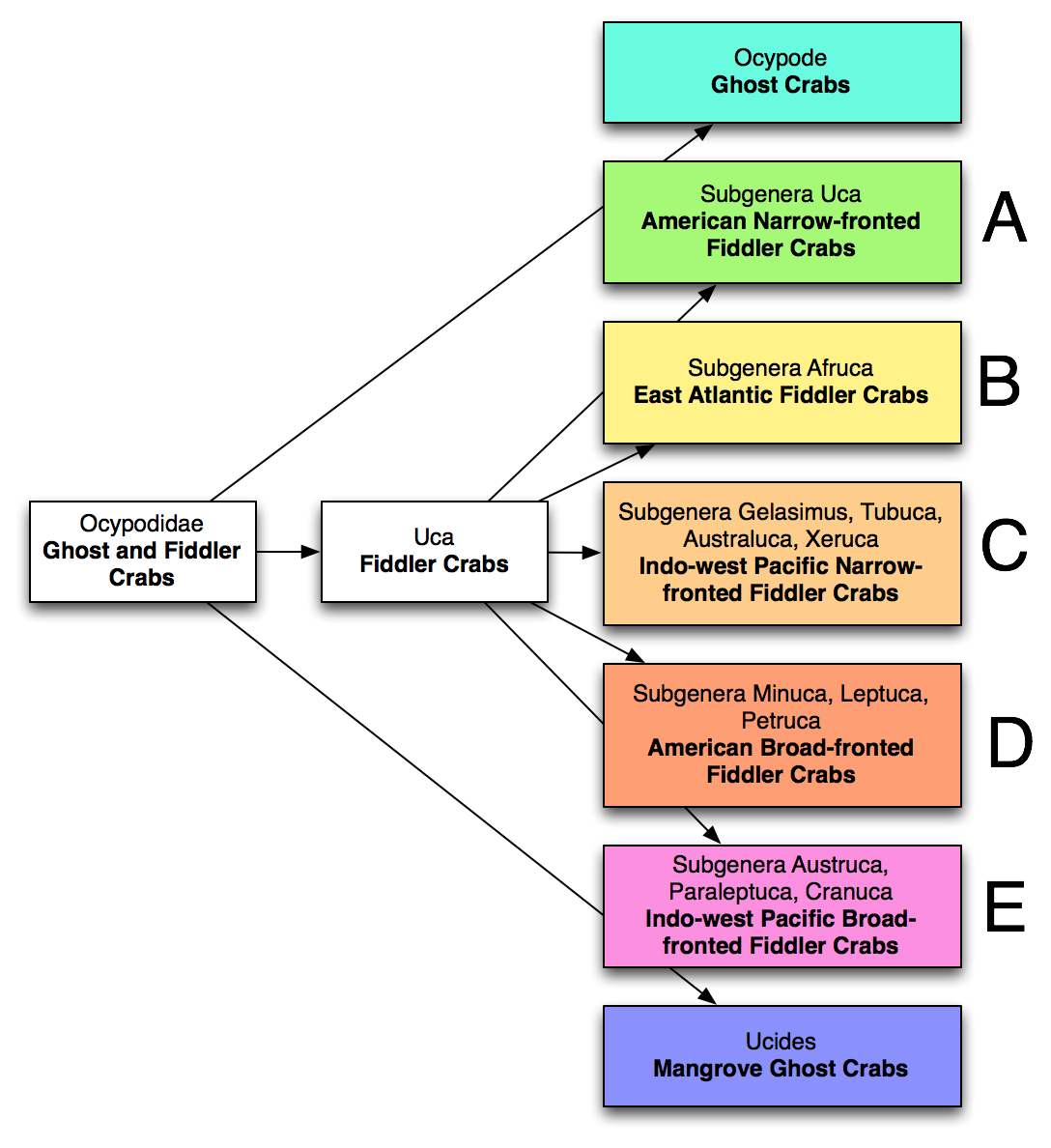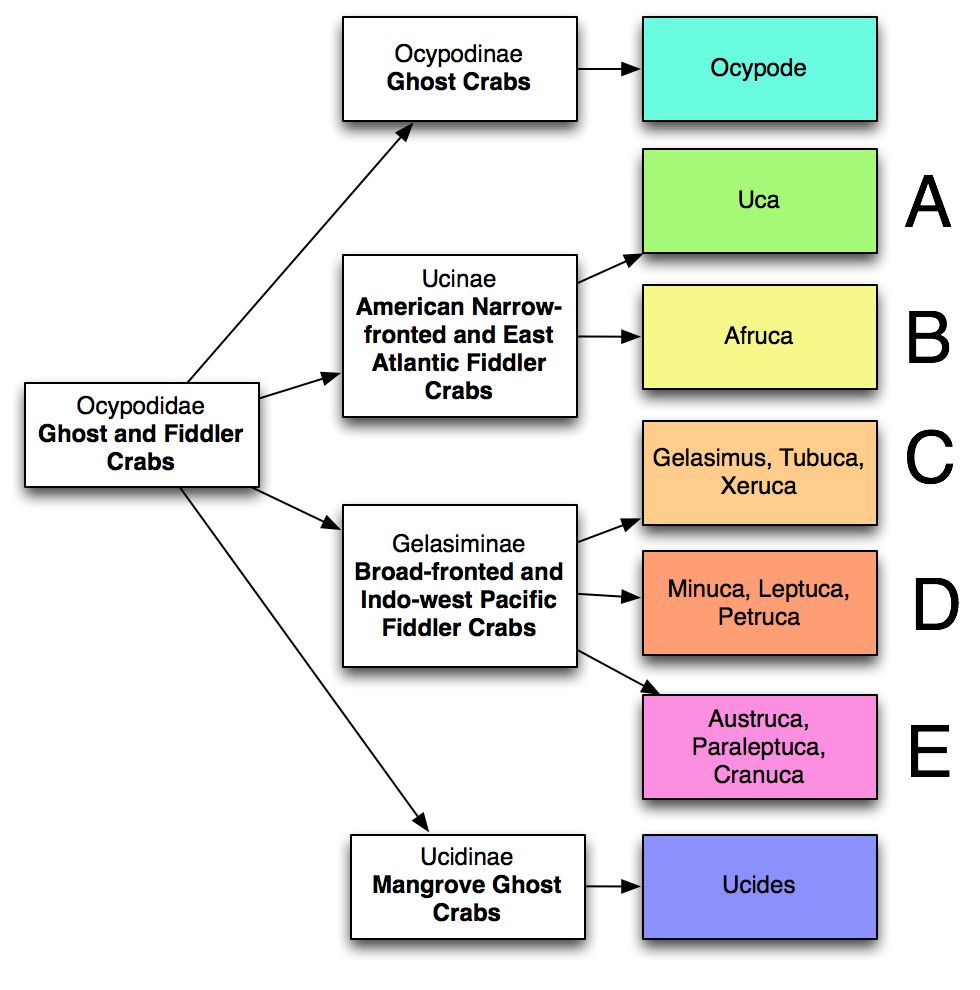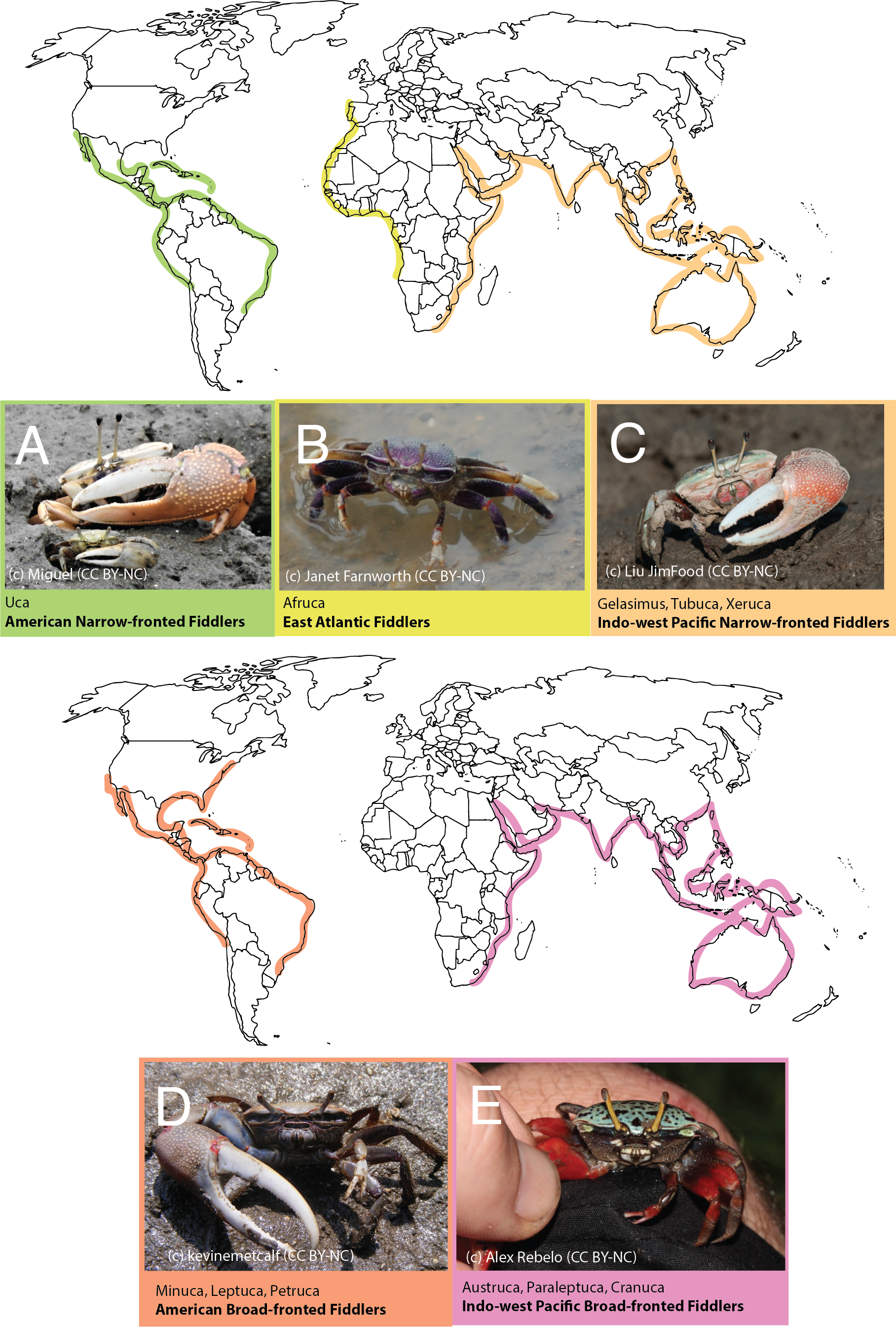Fiddler Crab Taxonomy
iNaturalist's policy is to follow WoRMs for marine species taxonomy. Unfortunately, this has resulted in a recent disruption of the familiar Fiddler Crab genus Uca.
Since curators had already begun swapping Fiddler Crab species with the new names in WoRMs, I've taken it upon myself to finish up these ongoing taxonomic changes in the interest of consistency. I have to note that I'm not really a supporter of these changes since our key source of Fiddler Crab expertise on iNaturalist @msr (aka the author of www.fiddlercrab.info) is not on board with them, but I'm just following the existing WoRMs policy and recommend that if we want to make an exception and deviate from WoRMs we should have that discussion first.
Nevertheless, to help alleviate all the confusion that these changes have precipitated, I thought I'd write this little post to try to explain them as best as I can. Traditionally, the Ghost and Fiddler Crab family Ocypodidae had three genera:
- the Ghost Crabs Ocypode (sometimes with one species split off as Hoplocypode)
- the Mangrove Ghost Crabs Ucides (2 American species sometimes placed in their own family Ucididae)
- the Fiddler Crabs as a single genus Uca (as on www.fiddlercrab.info)
This traditional treatment divides the genus up into 12 subgenera which can be coarsely grouped based on geography and morphology into the American Narrow-fronted Fiddler Crabs, the East Atlantic Fiddler Crabs, the Indo-west Pacific Narrow-fronted Fiddler Crabs, the American Broad-fronted Fiddler Crabs, and the Indo-west Pacific Broad-fronted Fiddler Crabs.

A 2016 study by Shih et al. found that the Fiddler Crabs were paraphyletic - that is the Ghost Crabs are nested within the Fiddler Crabs. Assuming their finding is correct, this means that in order ensure that our taxonomy reflects evolutionary history we must either lump Ghost Crabs into Fiddler Crabs or split Fiddler Crabs up. They opted to do the latter. Shih et al's approach was to elevate all the traditional Fiddler crab subgenera to generic status (except Australuca which they lumped into Tubuca). The Broad-fronted and Indo-west Pacific Narrow Fronted Fiddler Crabs were grouped into the family Gelasiminae and the American Narrow-fronted and East Atlantic Fiddler Crabs were grouped into the subfamily Ucinae (technically Shih and all put these in with Ghost Crab in the subfamily Ocypodinae but this is how WoRMs has it).

Unfortunately, a lot of observations on iNaturalist are just identified to the traditional genus Uca. Under these changes there is no longer a single node on the tree that can be used to pinpoint all fiddler crabs only. Our options are to identify them at the family level (Ocypodidae) which includes Ghost Crabs and Mangrove Ghost Crabs, or to identify them at the subfamily level which requires learning a bit more about Fiddler Crabs. Lets attempt to do that now.
Only in the Americas are both subfamilies present. The new narrower interpretation of Uca strictly refers to the American Narrow-fronts Fiddler Crabs (part of Ucinae) which as the common name suggests (these names come from Shih et al) have very narrow spaces between long eyestalks and look quite different from the American Broad-fronted Fiddler Crabs (part of Gelasiminae) in three genera with much broader spaces between relatively shorter eyestalks. Also helpful, for the most part only the Broad-fronted Fiddler Crabs make it as far north as the United States.
In the Eastern Atlantic its also very simple with the monotypic genus Afruca (part of Ucinae) being the only species present.
In the Indo-west Pacific only the subfamily Gelasiminae is present. But getting a handle on the genera is more complex. Shih et al name two groups present in the Indo-west Pacific: narrow-fronted and broad-fronted. But in my judgement the morphological differences between these groups of genera are much less pronounced than in the similarly named American groupings.

If you want to try your hand at identifying fiddler crabs 'lost' at the family level to subfamily or beyond here's some to play with.
I hope this helps. This is a very interesting group of crabs where there's a lot to be discovered and a group that naturalists tend to notice and observe. It would be a shame if the confusion caused by the WoRMs taxonomy changes made this group less accessible. I hope this post encourages everyone to take a little bit more time to at least learn the new subfamilies so we can continue to work together to document these cool little crabs.
Update: the 3 figures were updated to fix the labeling bug described by msr below





Comentarios
A few minor comments and additional explanation (as the person behind www.fiddlercrab.info and one of the conscientious objectors to the new taxonomy :-)
First, I think Scott did a really good job of explaining the major issue, although in his first figure the genera in C are broad-front and those in E are narrow-front (it's easy to lose track of these and mix them up).
Second, with minor exception, the paper by Shih et al 2016, does not change or challenge any of the more established beliefs about major groupings within the fiddler crabs (many of which, to be fair, have come from other papers by Shih and colleagues over the past decade or so). As mentioned by Scott, the big result was that it placed Ghost Crabs inside Fiddler Crabs, and a strict adherence to monophyletic names forced them to split fiddler crabs up. They give absolutely no other justification for this split, and even state in the paper that they cannot point to a single physical character that supports these divisions (the results are all based on DNA, as are most of the more solid phylogenetic work conducted today).
Boiled down, my objection to this name change is the only justification they use to split fiddler crabs up is this phylogenetic result, and I simply do not believe it. I (and some other fiddler crab researchers who I've spoken with) find the phylogeny which puts ghost crabs inside fiddler crabs to be...implausible. It simply doesn't make a lot of sense, evolutionarily. It requires virtually the entire suite of characteristics that make fiddler crabs to have either evolved completely independently twice or to have evolved once and then completely reversed themselves in Ghost Crabs (and I should note that although ghost crabs are clearly closely related to fiddler crabs, ghost crabs are quite a bit more similar to non-fiddler crabs than to fiddler crabs in many key characteristics).
These characteristics include things like (1) sexual dimorphism (male and female fiddler crabs are very different, male and female ghost crabs are identical), (2) extreme male asymmetry (male fiddler crabs are extremely asymmetric, females are symmetric; male and female ghost crabs are mildly and equally asymmetric), and (3) feeding: fiddler crabs are all deposit feeders (they scoop mud with their small claws and extract organic material from it) while ghost crabs are all predators. There are others, but these are among the most obvious.
My suspicion is that this odd result is a data artifact. I don't think it's an analytical issue, and to be clear, the people who wrote this paper are very good at what they do. However, this particular result is based on only three gene fragments, two from mitochondria (which are not independent) and one from the nuclear genome, which also means your mixing a fairly limited amount of data with two different evolutionary histories together...I suspect these two issues combine to create the odd result. This sort of data is very commonly used in many similar types of studies, so there is nothing particularly unusual in this choice, but I have become more convinced its simply not adequate to a lot of phylogenetic problems and can lead to overconfidence in spurious results. My hope is that one day someone (perhaps myself) will be able to sequence a larger amount of DNA per species (20 ore more complete nuclear genes) and redo the analysis, either confirming or rejecting this result.
Until then, we're basically stuck with it. The International Code of Zoological Nomenclature (ICZN) does NOT require us to follow this subdivision or use these generic names. Taxonomists can completely ignore it if they don't agree with it. The decision to follow these names stems from iNaturalist's policy to use the WORMS database as the authority. In this particular case, WORMS happens to be slightly biased by the fact that the curator of Brachyura for WORMS is also one of the authors on the paper, but again, these are very good scientists. I just am suspicious of this particular result. On the other hand, I think iNaturalist needs to stick to a consistent policy, even though its mildly painful (in my view) in this particular instance.
thanks for catching that labeling issue! I updated the figures in the post
I have a proposal that might help clarify a few things slightly. Right now we're using Ucinae for the American narrow-front and the East African fiddlers (genera Uca and Afruca) and Gelasiminiae for the rest of the fiddler genera. While the latter is correct, it is also confusing because it conflates the american broad-front with all of the Indo-West Pacific species. All evidence (multiple papers over many years, including the Shih et al 2016 mentioned above) suggests that the American broad-front are one clade and the Indo-West Pacific are another clade. Can we name Tribes (or put another way, can I name tribes)? The IWP would be in the Tribe Gelasimini (genera: Tubuca, Xeruca, Gelasimus, Cranuca, Paraleptuca, and Austruca) while the American Broad-front would be in the Tribe Minucini (genera: Minuca, Leptuca, an Petruca). This is completely congruent with current classification but allows us to narrow identifications down to somewhat narrower focus when the genus is unclear. Essentially we're just adding labels to two major unlabeled branches of the currently accepted phylogeny.
Añade un comentario